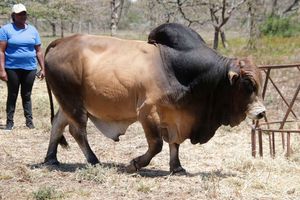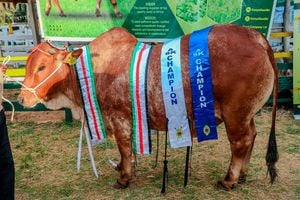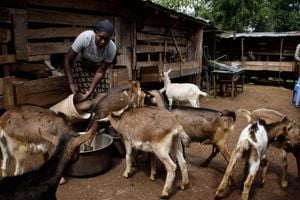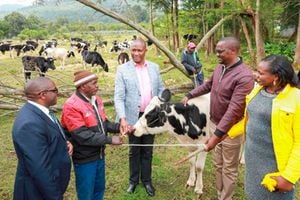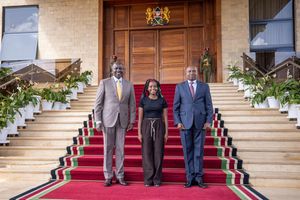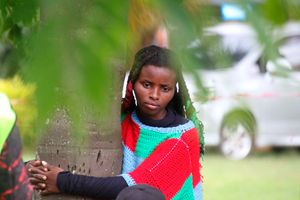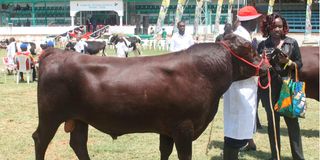
A Hereford bull at an agricultural fair.
As more people look to beef feedlot farming, I keep getting questions ranging from the type of profitable farming, type of animals to keep and the market for the animals.
Someone even asked at what weight the animals should be slaughtered. My answer is that it depends on the target market.
Some markets, for instance, ask for veal calves. These are calves slaughtered at 16 to 18 weeks of age and weigh about 200 kilos. The age and the weight are important because in the Kenyan situation, most calves are still far below 200kg when 18 weeks old.
The main reason the calves have such low weight is poor feeding, imbalanced nutrition and poor rumen development because of failing to introduce grains to the diet early enough.
Calves with poor rumen development may be fed properly but will still grow poorly as they are unable to digest fibre like grass.
Normally, such calves will have low weight, look forlorn and have pot bellies or distended abdomens.
Veal calves are normally male dairy. They are slaughtered because they do not have a role in milk production, except the few high-value genetics ones that are sold to semen production facilities.
The advent of artificial insemination, where a bull is able to breed thousands of cows, condemned the majority of bull calves to early slaughter.
In fact, some farms destroy the calves altogether and feed the carcasses to dogs.
Veal is more expensive than beef because there are few producers, the slaughter weight of the animal is low and the product is considered premium.
Veal is not a common in Kenya. Incidentally, there are people who feel uncomfortable eating calves as they consider them babies that should not be killed. I am one of those people.
The other market demand are animals between 400 and 500kgs when well-finished. This is the most common demand, especially for the export market. At this weight, the animals have a good balance between fat and muscle.
Most of the fat is white, rather than predominantly yellow. Most consumers prefer meat with white fat.
Interestingly, the meat colour has no impact on taste or texture. The yellow colour is caused by accumulation of carotene from the feed .
It is seen more in animals predominantly fed on pasture. Beef cattle on grain diet have white fat, depending on the length of time they have fed on the grains.
The other class of weight is more than 500kgs live weight. The weight can go up to the maximum for the breed of animal.
Most local beef breeds attain a final weight of 600 to 850kgs while the European mainly attain weights of 900 to 1200kgs.
A feedlot farmer buys animals at a weight that will enable her build the weight of the animals to a target weight that is marketable and profitable.
The most common practice in Kenya is to buy animals at 250 to 350kgs, then build the weight to 400 to 550kg within 90 days.
The other question I would like to deal with is the type of animals that one needs to recruit into a feedlot for profitable farming.
“Type” is a general term that encompasses the state of the animals and their breeds.
In addition to the weights I mentioned, animals should be healthy, of large body frame and underweight for their size so that they will have areas to deposit fat and grow muscle.
This means the bones should be prominent and body depressions visible.
The animals must have completed their growing phase to avoid feed wastage on growth.
One should also buy animals that are vaccinated against common diseases in the area they have been raised.
Animals from dry lands should have been vaccinated against contagious bovine pleuropneumoni or CBPP, among other diseases.
The other component of the term “type” is the breed of the animal. In Kenya, most feedlot animals are obtained from the arid and semi-arid lands.
They are mostly referred to as the local breeds but the correct name is Bos indicus or humped cattle breeds.
Bos indicus is the name given to a large group of cattle originating from India. Their main characteristics are the hump and resistance to pests and some tropical diseases.
However, continued vaccination and the use of pesticides to control pests has lowered the resistance of farmed cattle.
It is, therefore, always advised that the cattle should be treated against pests and diseases for prevention of illnesses to ensure uninterrupted weight gains when the animals are in the feedlot.
Boran and Sahiwal are the most common and suitable breeds of Bos indicus cattle that are reared in feedlots in Kenya. Other breeds like the Brahman are rare.
The second group of cattle suitable for feedlot farming are the European breeds, collectively called Bos taurus.
They are characterised by large bodies weighing from 1,000 to 2,000kgs.
The Bos taurus are fast growing and attain puberty at eight to 10 months as compared to 16 to 18 months for the Bos indicus.
They also gain weight faster and have more fat in the muscles than the Bos indicus. The meat is, therefore, tastier and more preferred by consumers.
Bos taurus meat is more tender than that of Bos indicus.
There is a shifting demand for Bos taurus meat and live animals in the Kenyan export market.
Kenyans going into feedlot farming should, therefore, progressively shift to Bos taurus cattle and their mixes and cross breeds with Bos indicus.
The most common Bos taurus beef cattle breeds in Kenya are the Charlorais, Hereford, Simental and Angus.
These breeds are, however, still in small numbers. But there are many other breeds of beef cattle in the world.
The duo-purpose Friesian and Ayrshire bulls are used in some feedlots but it is more advisable for cattle producers to focus on purely beef animals rather than the duo-purpose ones.
Unfortunately, beef cattle farming is automatically designed for medium to large scale production because one has to invest money until the animals mature for sale; unlike dairy farming where the farmer earns income daily through milk sales.

